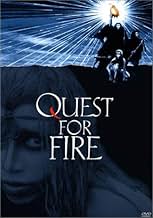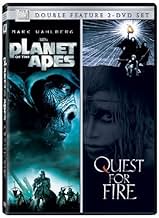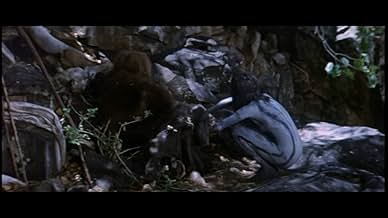IMDb RATING
7.3/10
26K
YOUR RATING
This story takes place in prehistoric time when three tribesmen search for a new fire source.This story takes place in prehistoric time when three tribesmen search for a new fire source.This story takes place in prehistoric time when three tribesmen search for a new fire source.
- Director
- Writers
- Stars
- Won 1 Oscar
- 11 wins & 8 nominations total
Nicholas Kadi
- Gaw
- (as Nameer El-Kadi)
Franck-Olivier Bonnet
- Aghoo - The Ulam Tribe
- (as Frank Olivier Bonnet)
Joy Boushel
- The Ulam Tribe
- (as Joy Boushell)
- Director
- Writers
- All cast & crew
- Production, box office & more at IMDbPro
Featured reviews
This is an extremely overlooked film many people should learn about. First, it tells you a very complex story without a single line of dialog successfully.
Second, the story is universal: Every civilization on earth can pick up this film and understand it, because it goes to the most basic, primitive issues of a species (mainly, survival). Third, it makes the beginning of man interesting. Fourth, it reminds us we were once as savage as any other animal on earth.
Fifth, it's like no other movie you've seen before. That one I can guarantee you.
Second, the story is universal: Every civilization on earth can pick up this film and understand it, because it goes to the most basic, primitive issues of a species (mainly, survival). Third, it makes the beginning of man interesting. Fourth, it reminds us we were once as savage as any other animal on earth.
Fifth, it's like no other movie you've seen before. That one I can guarantee you.
I saw this film (on VHS rental) so long ago I might have been in it. My (ex) wife & friends thought it was stupid - "What's going on? Nobody's saying anything". I found it mesmerising and have been looking for it ever since (car boot sales, Ebay etc).
OK, if you've two adjacent brain cells, you'll spot the anachronisms and the cheap effects, but credit where it's due for originality and balls - to the director and the backers.
If you're sick of hype and tripe, find it. If you're hooked intravenously to Hollywood pap (as 99.999% of the world's population seem to be) then give it a miss.
Just my 2p.
OK, if you've two adjacent brain cells, you'll spot the anachronisms and the cheap effects, but credit where it's due for originality and balls - to the director and the backers.
If you're sick of hype and tripe, find it. If you're hooked intravenously to Hollywood pap (as 99.999% of the world's population seem to be) then give it a miss.
Just my 2p.
I recall when this film was released. If memory serves, the hype concerned the efforts to turn an elephant into a mastodon using make-up and an actress running around nude. In other words, the film in my mind fell into the 'One Million Year BC' category and I ignored it.
Later, I learned who Annaud was and admired 'The Name of the Rose' for its direction, its translation of a difficult book and its effort at realism. Finally, I rented 'Quest for Fire' on DVD and saw it on the big home screen. (In fact, I watched it several months ago and I'm commenting now because it remains in my mind.)
Experts can quibble about the realism. But for me, this film makes an intelligent and credible effort to present a world of 80,000 years ago. In this, it raises good questions about who we are as a species. Human genetic code has not changed in that time and any one of the beings portrayed would be perfectly capable of using a computer as I'm doing now. Nonetheless, they lived in a world without numbers, without prices, without trade, without written language and without means to create fire. Everyone alive today had an ancestor who survived those conditions. 'Quest for Fire' is a must-see for anyone curious about the human condition.
Later, I learned who Annaud was and admired 'The Name of the Rose' for its direction, its translation of a difficult book and its effort at realism. Finally, I rented 'Quest for Fire' on DVD and saw it on the big home screen. (In fact, I watched it several months ago and I'm commenting now because it remains in my mind.)
Experts can quibble about the realism. But for me, this film makes an intelligent and credible effort to present a world of 80,000 years ago. In this, it raises good questions about who we are as a species. Human genetic code has not changed in that time and any one of the beings portrayed would be perfectly capable of using a computer as I'm doing now. Nonetheless, they lived in a world without numbers, without prices, without trade, without written language and without means to create fire. Everyone alive today had an ancestor who survived those conditions. 'Quest for Fire' is a must-see for anyone curious about the human condition.
"Quest for Fire" (1981 - 100 minutes), under Jean-Jacques Annaud direction and written by Gérard Brach, was based on the book of J. H. Rosny. The movie develops a travel in time showing one of the biggest conquest of human kind: the domain of fire. It's a 80 thousand years ago beautiful drama. The Ulan tribe lives nearby a natural source of fire. When the fire went out, three members of the tribe have to search for a new flame. After several days of walking and having to face many dangerous situations like wild animals, down temperatures and even cannibal tribes, they found the Ivakas, a more evolved human group that had already discovered how to "make" fire. With locations in Kenya, Scotland, Island and Canada, the movie was based on scientific knowledge, showing convincing habitats and characters. The preparation work of the actors body language was done by the Anthropologist Desmond Morris and Anthony Burgess took care of the "talking" of these human ancestors. Almost an Anthropology documentary, this excellent movie shows at the end a scene that suggests the "discovery of love" between male and female. Absolutely unforgettable.
I caught this in Boston back in 1981. They played it in the biggest cinema they had in 70mm and in stereo sound. I had only the slightest idea of what it was about but it sounded interesting. When I realized it was a caveman movie I almost left, but the beautiful wide screen cinematography kept me in my seat. Slowly it worked on me and by the end I was mesmerized.
There's not really much of a plot--the caveman discover fire and different sexual positions--and there's no dialogue that we could understand but it didn't matter. The whole cast was excellent--especially Ron Perelman and Rae Dawn Chong (who had guts to do this). Their whole performances had to be done using some foreign language and body movement but they pulled it off. I heard Anthony Burgess was called in to develop the language used and coach the cast in how to use it. The cinematography is just breath-taking and the prehistoric animals look realistic all the way. I can't exactly say why I loved this movie but I did.
20th Century Fox deserves credit for actually acquiring the film and releasing it. Naturally it bombed badly here in the US but it seems I'm not the only one who likes it--when I mention it to friends I just get a blank look back. I haven't seen it since 1981 but it's never left me. Try to see it on a big screen TV. I give it an 8.
There's not really much of a plot--the caveman discover fire and different sexual positions--and there's no dialogue that we could understand but it didn't matter. The whole cast was excellent--especially Ron Perelman and Rae Dawn Chong (who had guts to do this). Their whole performances had to be done using some foreign language and body movement but they pulled it off. I heard Anthony Burgess was called in to develop the language used and coach the cast in how to use it. The cinematography is just breath-taking and the prehistoric animals look realistic all the way. I can't exactly say why I loved this movie but I did.
20th Century Fox deserves credit for actually acquiring the film and releasing it. Naturally it bombed badly here in the US but it seems I'm not the only one who likes it--when I mention it to friends I just get a blank look back. I haven't seen it since 1981 but it's never left me. Try to see it on a big screen TV. I give it an 8.
Did you know
- TriviaBoth Ron Perlman and Everett McGill suffered frostbite; luckily they were able to heal completely. Despite the working conditions, they both enjoyed making the film.
- GoofsThe movie is set 80,000 years ago, and appears to show the one tribe has made pottery. Fragments of ancient pottery found in southern China date back to only 20,000 years, making them the world's oldest known pottery. However, the vessel shown is actually a dried hollow gourd.
- Quotes
[first lines]
Title Card: 80,000 years ago, man's survival in a vast uncharted land depended on the possession of fire. / For those early humans, fire was an object of great mystery, since no one had mastered its creation. Fire had to be stolen from nature, it had to be kept alive - sheltered from wind and rain, guarded from rival tribes. / Fire was a symbol of power and a means of survival. The tribe who possessed fire, possessed life.
- Alternate versionsAll UK versions are cut by 8 secs and are missing a shot of a wolf on fire.
- ConnectionsFeatured in À propos de 'La guerre du feu' (1981)
- How long is Quest for Fire?Powered by Alexa
Details
- Release date
- Countries of origin
- Languages
- Also known as
- La guerra del fuego
- Filming locations
- Production companies
- See more company credits at IMDbPro
Box office
- Budget
- $12,500,000 (estimated)
- Gross US & Canada
- $20,959,585
- Gross worldwide
- $20,962,615
- Runtime
- 1h 40m(100 min)
- Color
- Aspect ratio
- 2.35 : 1
Contribute to this page
Suggest an edit or add missing content


![Bande-annonce [OV]](https://m.media-amazon.com/images/M/MV5BZTg3YWU0MTMtMDk1Mi00M2Y4LWFiODgtYzFhOTAyMWRjYWY2XkEyXkFqcGdeQXRyYW5zY29kZS13b3JrZmxvdw@@._V1_QL75_UY281_CR74)





























